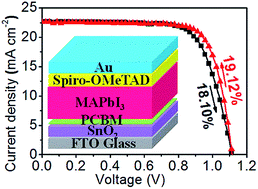Cooperative tin oxide fullerene electron selective layers for high-performance planar perovskite solar cells†
Abstract
Both tin oxide (SnO2) and fullerenes have been reported as electron selective layers (ESLs) for producing efficient lead halide perovskite solar cells. Here, we report that SnO2 and fullerenes can work cooperatively to further boost the performance of perovskite solar cells. We find that fullerenes can be redissolved during perovskite deposition, allowing ultra-thin fullerenes to be retained at the interface and some dissolved fullerenes infiltrate into perovskite grain boundaries. The SnO2 layer blocks holes effectively; whereas, the fullerenes promote electron transfer and passivate both the SnO2/perovskite interface and perovskite grain boundaries. With careful device optimization, the best-performing planar perovskite solar cell using a fullerene passivated SnO2 ESL has achieved a steady-state efficiency of 17.75% and a power conversion efficiency of 19.12% with an open circuit voltage of 1.12 V, a short-circuit current density of 22.61 mA cm−2, and a fill factor of 75.8% when measured under reverse voltage scanning. We find that the partial dissolving of fullerenes during perovskite deposition is the key for fabricating high-performance perovskite solar cells based on metal oxide/fullerene ESLs.



 Please wait while we load your content...
Please wait while we load your content...